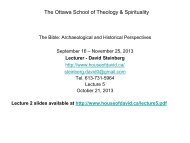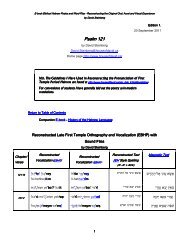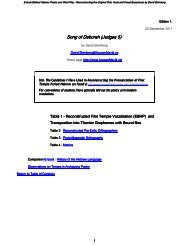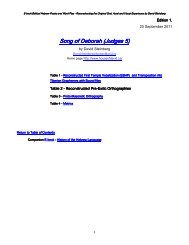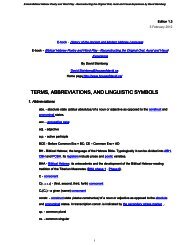Biblical Hebrew Poetry - House of David Steinberg
Biblical Hebrew Poetry - House of David Steinberg
Biblical Hebrew Poetry - House of David Steinberg
You also want an ePaper? Increase the reach of your titles
YUMPU automatically turns print PDFs into web optimized ePapers that Google loves.
42<br />
E-book<br />
<strong>Biblical</strong> <strong>Hebrew</strong> <strong>Poetry</strong> and Word Play - Reconstructing the Original Oral, Aural and Visual Experience by <strong>David</strong> <strong>Steinberg</strong><br />
The analysis <strong>of</strong> English vowels [j y ] and [e y ] with and <strong>of</strong>f-glide [ y ], and [u w ] and [o w ] with and <strong>of</strong>f-glide [ w ],<br />
finally made linguists aware <strong>of</strong> an alternative to vowel-length. Physically the difference in sound between<br />
lengthening and <strong>of</strong>f-glide may be quite small, especially between [iː] and [i y ] or between [uː] and [u w ]. In<br />
English both lengthening and an <strong>of</strong>f-glide are <strong>of</strong>ten discernable in the very same syllable at the same<br />
time. but when we turn to the ancient <strong>Hebrew</strong> texts and examine the evidence, the only conclusion that<br />
makes sense is that the scribes could and did record <strong>of</strong>f-glides. Vowels, whether lengthened or not,<br />
escaped their means <strong>of</strong> notation, a consonantal alphabet, just as accents and other supra-segmental<br />
features did.<br />
61 Manuel 1995 p.41.<br />
62 Outside <strong>of</strong> closed unstressed syllables, which excluded long vowels, Early <strong>Biblical</strong> <strong>Hebrew</strong> (i.e. late phase 3)<br />
pronunciation had a phonemic distinction between long and short vowels.<br />
63 Blau 2010 §3.5.7.2.1.<br />
64 Blau 2010 §3.5.7.2.1.<br />
65 IN EBHP and LBHP THE JUSSIVE (PCjus), COHORTATIVE (PCcoh), IMPERFECT (PCimp) AND PRETERITE<br />
(PCpret_sim/PCpretWC) are, in some forms, distinguished by the placement <strong>of</strong> syllabic stress when not carrying<br />
object suffixes. See -<br />
- http://www.adath-shalom.ca/history_<strong>of</strong>_hebrew3a.htm#indic_jus AND<br />
- http://www.adath-shalom.ca/history_<strong>of</strong>_hebrew3a.htm#Prefix_Conjugation<br />
66 See Blau 2010 §3.5.13.<br />
67 Bergsträsser §17q.<br />
68 [y] = [j]<br />
69 See the work <strong>of</strong> Rooker, Hurvitz, Polzin. See Some Factors in the Rise <strong>of</strong> Late <strong>Biblical</strong> <strong>Hebrew</strong><br />
70 See Blau 2010 §3.5.12.2.6 - 3.5.12.2.8. Note that this is in contrast to the ambient Aramaic which generally<br />
maintained its stress structure -<br />
"The pattern <strong>of</strong> word-stress ... appears, in general, to be that <strong>of</strong> <strong>Biblical</strong> Aramaic, Targum Onqelos, and<br />
Syriac: stress is penultimate when the final syllable is a vowel, except in the case <strong>of</strong> vowels which are<br />
reflexes <strong>of</strong> original diphthongs or originally closed syllables; otherwise it is ultimate. Evidence for the<br />
stress pattern comes from three sources: the consonantal text, the vocalized text, and the position <strong>of</strong> the<br />
accent signs." Fassberg 1991 p. 75.<br />
Note the jussive stress shift evidenced in the Secunda.<br />
71 The following is quoted from Hetzron 1969 P. 20 (See also Lipinski 1997 §38.2) -<br />
“Evidence brought from East Semitic (Akkadian), Central Semitic (biblical <strong>Hebrew</strong> in its Tiberian form) and south<br />
Semitic … points to the existence in proto-Semitic <strong>of</strong> a perfect *yʹaqtul, with stress on the prefix and a jussive<br />
*yaqtʹul, with final stress. Since the stress-system <strong>of</strong> each branch <strong>of</strong> Semitic was later reorganized, this stress-



